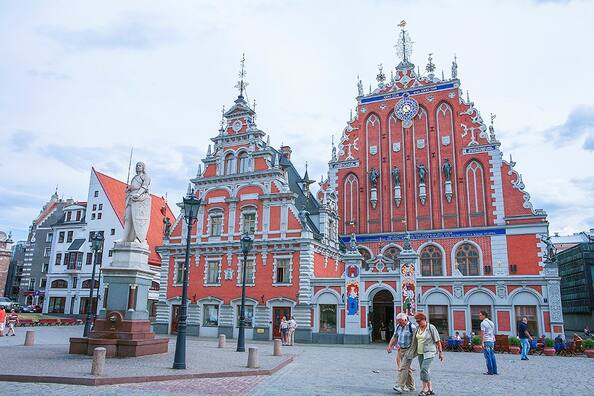Centro histórico de Riga
Historic Centre of Riga
Riga was a major centre of the Hanseatic League, deriving its prosperity in the 13th–15th centuries from the trade with central and eastern Europe. The urban fabric of its medieval centre reflects this prosperity, though most of the earliest buildings were destroyed by fire or war. Riga became an important economic centre in the 19th century, when the suburbs surrounding the medieval town were laid out, first with imposing wooden buildings in neoclassical style and then in Jugendstil . It is generally recognized that Riga has the finest collection of art nouveau buildings in Europe.
Description is available under license CC-BY-SA IGO 3.0
Centre historique de Riga
Riga était un grand centre de la Ligue hanséatique qui a prospéré grâce au commerce avec l'Europe centrale et de l'Est aux XIIIe -XVe siècles. Le tissu urbain de son centre médiéval reflète cette prospérité, bien que la plupart de ses bâtiments les plus anciens aient été détruits par l'incendie et la guerre. Au XIXe siècle, elle est devenue un important centre économique et l'on a construit les faubourgs de la ville médiévale, tout d'abord en imposant une architecture en bois de style classique, puis Jugendstil. De l'avis général, c'est à Riga que l'on trouve la plus belle concentration de bâtiments Art nouveau d'Europe.
Description is available under license CC-BY-SA IGO 3.0
الوسط التاريخي في ريغا
كانت ريغا مركزًا كبيرًا للجامعة التحالفيّة التي ازدهرت بفضل التجارة مع أوروبا الوسطى والشرق منذ القرن الثالث عشر وحتى القرن الخامس عشر. ويعكس النسيج الحضري لوسطها الذي يعود إلى القرون الوسطى، هذا الازدهار مع أنّ معظم أبنيتها القديمة قد دُمرت بسبب الحريق والحرب. وفي القرن التاسع عشر، أصبحت هذه المدينة مركزًا اقتصاديًّا مهمًّا وقد بُنيت ضواحي المدينة التي تعود إلى القرون الوسطى، أولاً بفرض هندسةٍ خشبيّةٍ تتميّز بالأسلوب كلاسيكي، ثم باستعمال اليوغندستيل. وبحسب الرأي العام، نجد في ريغا أجمل تجمّع للأبنية التي تعتمد على الفن الأوروبي الجديد.
source: UNESCO/CPE
Description is available under license CC-BY-SA IGO 3.0
里加历史中心
里加是汉萨同盟的一个主要中心,它同中欧和东欧的贸易在13世纪至15世纪一度非常繁荣。尽管大部分的早期建筑受到火灾和战争的破坏,但是中世纪中期的城市建筑仍然反映了这种繁荣。19世纪里加成为重要的经济中心,中世纪城镇的市郊已经建成,风格从开始的古典木制建筑转入“新艺术”风格。里加被公认为欧洲最精美的“新艺术”建筑风格的中心。
source: UNESCO/CPE
Description is available under license CC-BY-SA IGO 3.0
Исторический центр Риги
Центральной и Восточной Европы. Городская застройка ее средневекового центра отражает это процветание, несмотря на то, что большая часть старейших зданий была утрачена в результате пожаров и войн. В XIX в., когда Рига стала важным экономическим центром, вокруг средневекового ядра города возникли предместья, сначала с выразительными деревянными зданиями в стиле классицизма, затем – в стиле модерн (югендстиль или арт-нуво). Общепризнанно, что Рига обладает собранием самых прекрасных зданий в стиле модерн в Европе.
source: UNESCO/CPE
Description is available under license CC-BY-SA IGO 3.0
Centro histórico de Riga
Centro importante de la Liga Hanseática, la ciudad de Riga prosperó entre los siglos XIII y XV gracias al comercio con Europa Central y Oriental. El tejido urbano de su centro medieval muestra todavía esa prosperidad, aunque la mayoría de sus edificios más antiguos fueron destruidos por incendios y guerras. Riga volvió a ser un importante centro económico en el siglo XIX, época en la que se hizo el trazado de los suburbios situados en torno la ciudad medieval. Al principio se impuso la construcción en madera y estilo neoclásico para los nuevos edificios, pero luego fue predominando el “Jugendstil” o “Art Nouveau”. Según una opinión muy extendida, Riga posee hoy en día el más hermoso conjunto de edificios de “Art Nouveau” de toda Europa.
source: UNESCO/CPE
Description is available under license CC-BY-SA IGO 3.0
リガ歴史地区
ハンザ同盟の主要な中心地として、13世紀~15世紀の中欧・東欧貿易で繁栄した。中世の中心地の建造物はこの繁栄の例証であるが、初期の建造物の大半は火災と戦争で破壊された。19世紀には重要な経済的中心地となり、公害には壮大な古典様式の木造建造物や、ユーゲントシュティル様式(アール・ヌーヴォと同様式)の建造物が建てられた。source: NFUAJ
Historisch centrum van Riga
Riga was een belangrijk centrum van het Hanze-verbond. Het ontleende zijn welvaart aan handel met Midden en Oost-Europa van de 13e tot de 15e eeuw. Het stedelijke karakter van het middeleeuwse centrum weerspiegelt deze welvaart, hoewel de meeste van de vroegste gebouwen werden verwoest door brand of oorlog. Riga werd in de 19e eeuw een belangrijk economisch centrum, toen de voorsteden rond de middeleeuwse stad werden aangelegd. Eerst met indrukwekkende houten gebouwen in neoklassieke stijl en vervolgens in 'Jugendstil'. Het wordt algemeen erkend dat Riga de mooiste collectie Art Nouveau gebouwen van heel Europa heeft.
Source: unesco.nl
